Why Is Food Safety Important In Healthcare? Healthcare Leaders Guide
Learn challenges healthcare foodservice teams face today and key food safety practices to protect vulnerable patients. Get a free healthcare leader...
According to the Global Food Security Index, the overall score of food safety in America is lower than last year.
Businesses in the food industry always operate at risk. Food safety hazards are always present, and every business's responsibility is to protect public health. Food safety is a broad topic requiring intensive analysis and data gathering.
You can gain a better grasp and overview of the importance of food safety and the public health consequences of non-compliance through numbers and food safety statistics.
WHAT WE'LL COVER:
According to the Global Food Security Index, the overall score of America in terms of affordability, availability, sustainability and adaptation, and safety and quality is 13th among 113 countries in 2022. This ranking is three steps lower than its position in 2021.
On quality and safety metrics alone, the U.S. is a contender in third place for the GFSI 2022.
The last significant reform to the food safety system of the U.S. was when the Food Safety Modernization Act was signed into law in 2011. To date, the law is almost fully in effect and is regularly updated and amended for improvements.
Different countries and their governments have varying outlooks when it comes to food safety. Each country has its own version of its food safety laws and regulations that aim to protect the interest and safety of its constituents.
Below are some of the most notable regulations in food safety around the world:
Similar to the different interpretations of each country towards food safety, their requirement for establishing food safety plans may also vary.
As an effect of the recent pandemic, around 159,000 food businesses either temporarily or permanently closed down. Government orders that limited face-to-face interactions hit businesses that require the physical presence of consumers, such as food service businesses.
As health departments all over the world came to manage the pandemic better, limitations in access to food businesses have eased. The industry has started to open once again but maintains high alertness toward food safety measures.
Although strict guidelines on social distancing have started to ease out, food safety agencies continue to put focus on the necessity of food safety and hygiene practices. Operations such as frequent handwashing and regular cleaning and sanitizing of food contact surfaces and service tables are more essential than ever.
Food safety is an essential element for any food business to continue operating. Without compliance with food safety standards, a food business is bound for violations and closure.
Compliance with food safety ensures that the food items sold by a food business are safe and will not cause foodborne illnesses. When food safety compliance is not properly maintained, issues such as the following may arise:
Non-compliance with food safety regulations results in several problems in a food business and can be easily addressed with a proper management system. For example, FoodDocs makes compliance easy and accessible to any food business that sells or serves food.
Set up your digital Food Safety Management System in a matter of minutes to start using intuitive solutions to comply with everyday food safety tasks. Allow our system to remind food handlers whenever a task needs to be done on time.
Below, we give you some of the most significant food safety facts and statistics describing the U.S. scheme.
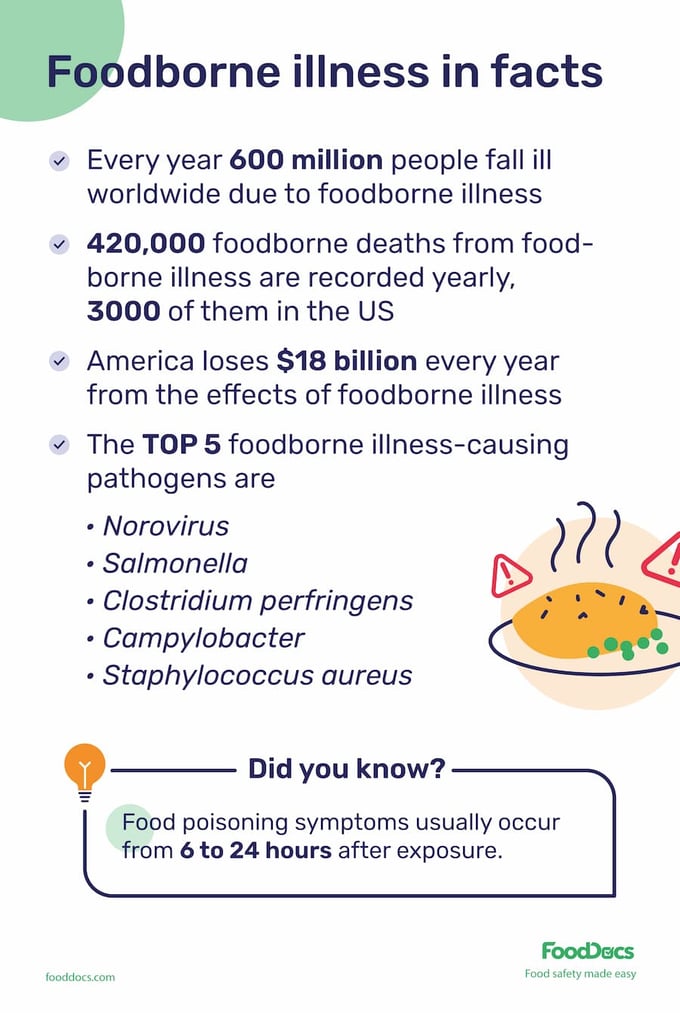
Total productivity loss in low- and middle-income countries as a result of foodborne illnesses was estimated to cost US$95.2 billion per year. Treating foodborne illnesses accounts for US$15 billion in spending from these countries, as estimated by the World Bank Group in 2019.
Foodborne illness outbreaks do not only cost the affected businesses. The estimates of disease burden also affect the other industries when an outbreak occurs. The workforce becomes limited, and the productivity of a business becomes significantly reduced. In addition, a country's health budget becomes focused on such cases that it loses the budget for other health concerns.
In the U.S., the effects of the 5 major foodborne pathogens identified by the Centers for Disease Control and Prevention (CDC) account for at least US$17.6 billion. The estimated cost of foodborne illness on Americans is reflected in the analysis that at least 48 million people get sick from food-related causes.
Among the biggest concerns regarding food safety in the U.S., the presence of chemicals in food and foodborne illnesses are ranked the highest. To learn more about foodborne illness, read our article What is a foodborne illness?
Based on the annual food safety statistics regularly conducted by the International Food Information Council (IFIC), 29% of consumers are most concerned with chemical contamination in food, which may have long-term health problems or chronic illness. The second highest concern is foodborne illness from bacteria which garnered 26%.
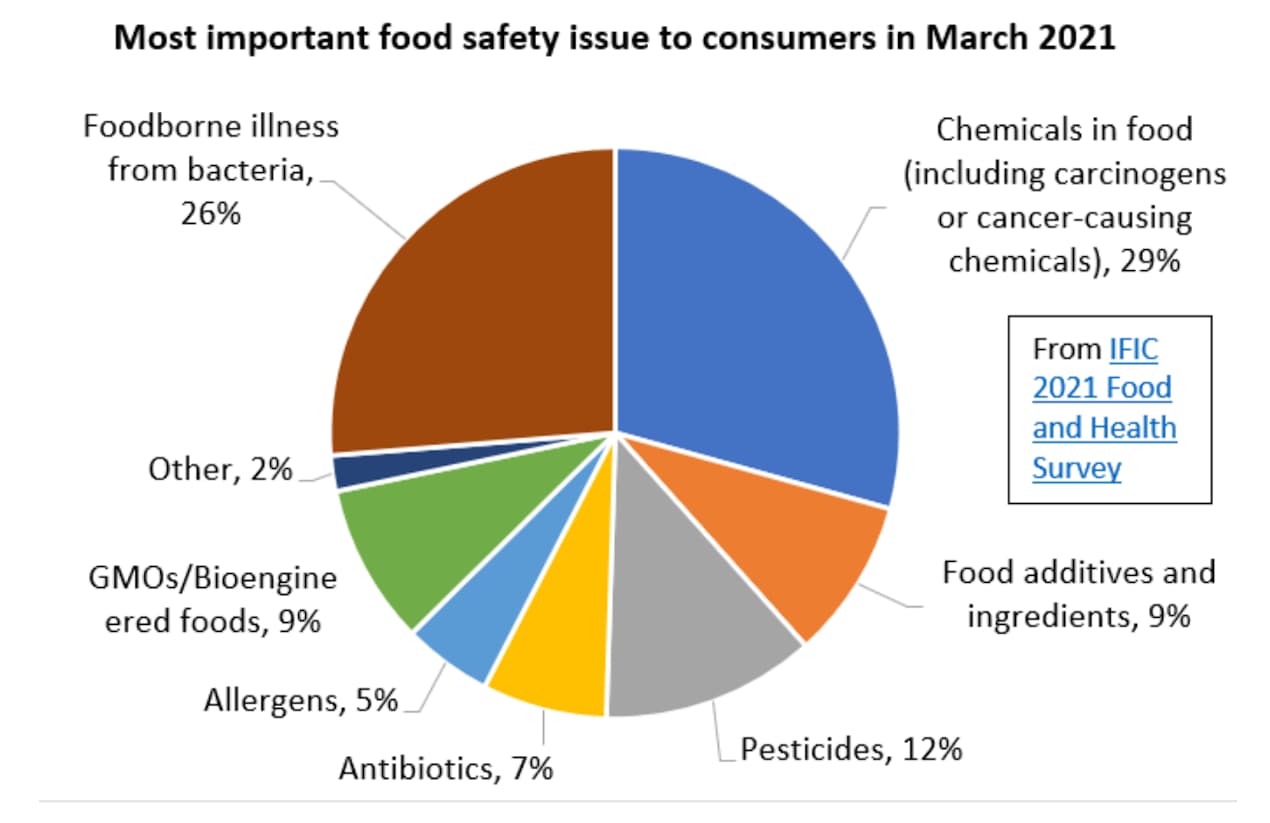
Most Important Food Safety Issue to Consumers
Since 2017, food consumers have seen the presence of harmful chemicals as a significant threat followed by foodborne illnesses from pathogenic microorganisms.
At least 250 foodborne illness-causing agents are identified as contributing to the food diseases experienced worldwide. These disease-causing organisms are mostly bacteria, viruses, fungi, and parasites.
Among the identified causes of foodborne diseases, five (5) of them cause the majority of foodborne illness cases in the U.S. The five main foodborne illness-causing microorganisms, according to the CDC, include:
These dangerous pathogens are transmitted from contaminated water or food handlers with poor food hygiene. Food safety agencies recommend practicing frequent and proper handwashing procedures to minimize the risk of spreading the growth of bacteria through cross-contamination.
Foodborne illnesses result from consuming foods contaminated with food safety hazards. These hazards are categorized as the following:
Foodborne illnesses may be deduced as the result of the presence of contaminants and improper food handling in food businesses.
Depending on the types of food safety hazards, the resulting foodborne infection may also differ. Food business owners and their food safety teams are responsible for controlling the presence of these hazards and minimizing their levels in the work setup.

Mild cases of food poisoning manifest symptoms from 6 to 24 hours after exposure. Typical food poisoning may last for 24 hours or less, depending on the severity of the case.
Some signs of food poisoning include:
Cases of food poisoning may last longer for more vulnerable consumer groups, such as pregnant women, children under five years old, the elderly, and those with weak immune systems.
Food poisoning can be controlled by maintaining a high level of fluids in the body and drinking proper medication as suggested by health professionals.
Severe cases of food poisoning can lead to deaths when not properly addressed. Foodborne illness statistics show that approximately 600 million people fall ill worldwide, and at least 420,000 deaths are recorded yearly. At least 30% of the recorded deaths are children under five years old.
In the U.S., an average count of 3,000 deaths from foodborne diseases occurs every year. With the effects of COVID-19 aside, foodborne illness cases in the U.S. has seen an upward trend over recent years.
The CDC released food safety statistics that show at least 1.35 million cases of food poisoning are caused by Salmonella every year in the U.S., leading to 420 deaths.
Raw foods normally contain a certain number of good and pathogenic microorganisms. Properly cooking foods ensure that neither good nor pathogenic microorganisms will cause any effect on consumers.
Consuming any type of raw food increases the risk of causing foodborne illness. Some of the foods most associated with foodborne illness outbreaks as a result of being eaten raw or undercooked include:
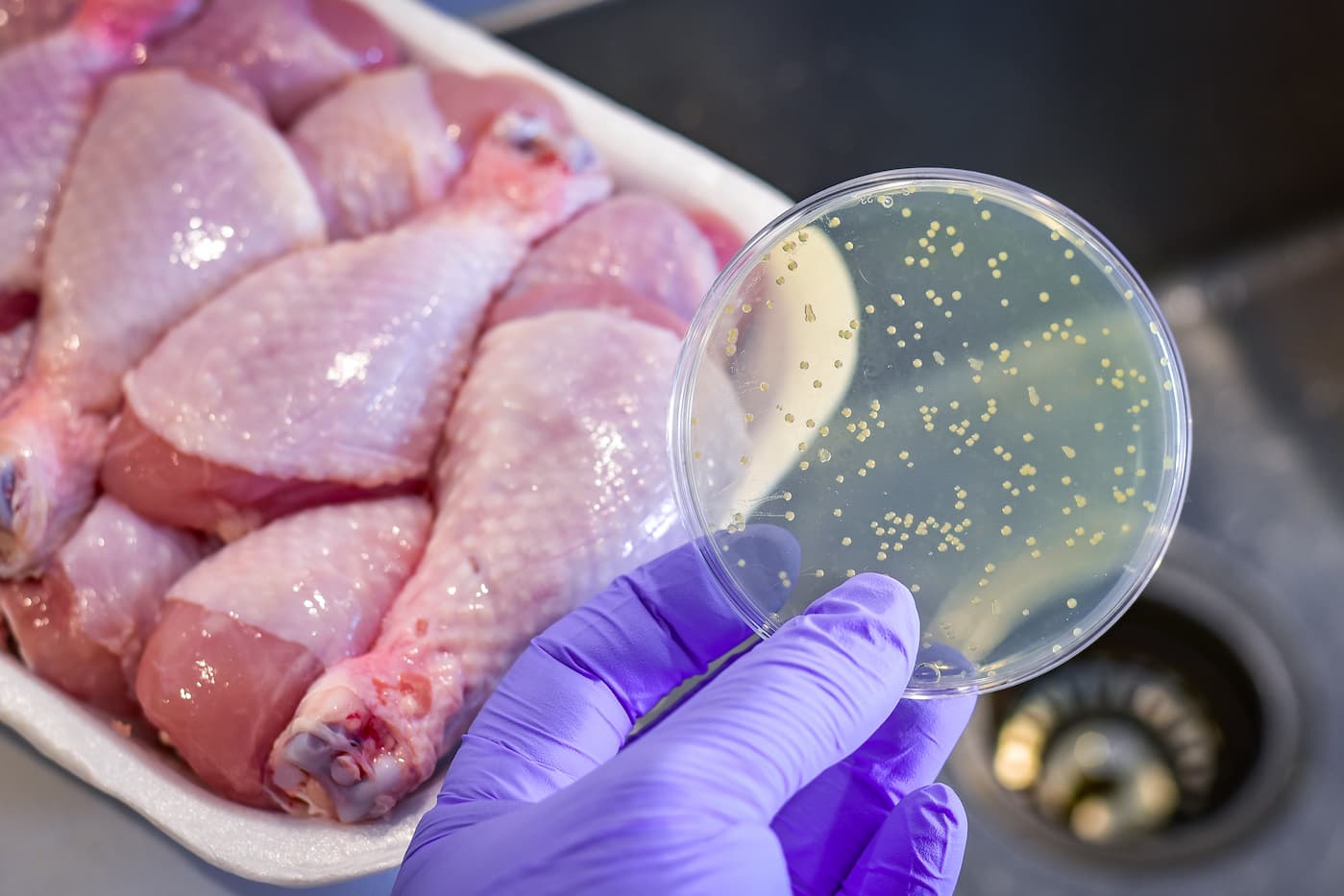
Foodborne illnesses are a sign of the potential improper holding of food within the entire food chain. They may be the result of inadequate cooking, poor food hygiene, and incorrect cleaning and sanitation procedures.
Foodborne illnesses can be significantly prevented by identifying their root cause and addressing them through a comprehensive food safety system. This system includes training employees on the most essential food practices, including the 4 C's of food safety:
Consistent maintenance through monitoring can ensure compliance with these food safety practices. These four core practices can help address the growth of harmful bacteria, unwanted chemical substances, and other common examples of food hazards that result in unsafe food.
Learn how proficient your team is when it comes to food safety practices with our free food safety quiz tool.
A food safety management system can help your team efficiently oversee the safety of your everyday operations. Recently, the demand from the globalization of food production, food exports, and wider food manufacturing operations has made it harder for new and existing food businesses to maintain compliance using traditional monitoring systems.
To help your food business improve efficiency, ensure the effectiveness of your food operations, and allow you to focus more on other aspects of running a business, use our digital solutions. With our digital Food Safety Management System software, you can get a comprehensive monitoring system with the most essential food safety document to stay compliant. The whole process of shifting to our digital platform only takes 15 minutes, and it does not need any assistance from food safety experts.
In relation to foodborne illnesses, one of the leading causes of anaphylaxis in American customers is the unintentional digestion of food allergens. Allergic reactions to food ingredients can be considered a foodborne illness, making them a priority concern in food safety management.
Food allergies can be life-threatening and can affect your business significantly. The occurrence of anaphylaxis among Americans has been estimated to occur in 1 in 50 customers, according to a study conducted by the Asthma and Allergy Foundation of America.
Learn more about how common food allergies are and which food ingredients can potentially trigger allergic reactions.
Food allergies are very common worldwide. In fact, the number of people affected by food allergies in the U.S. has doubled in the last decade.
Recent studies show an increase in the prevalence of food allergies in Western and developing countries. Among these food safety statistics, children were reported to be the most affected by food allergies.
In a study published in 2017, the prevalence of food allergy among Americans was only estimated to be around 3.6%. The same study also noted that other publications cited 5% to 8% estimates. Although varying, the number of Americans with detected food allergies is significantly lower than to date.
In 2019, a study with wider scope estimated that the prevalence of food allergy in the U.S. grew to 10.8% of the entire population.
The increasing cases of food allergies in the U.S. raise several concerns with unmonitored diets, such as when customers dine in restaurants. The most common cause of anaphylactic shock triggered by foods is reported to be peanuts, which is a very common ingredient in any food establishment.
As the food industry recognizes food allergies as an increasing threat to safety, food business owners are under more pressure to comply with food safety regulations. Food handlers are expected to have allergen controls in place to protect customers.
Reports show that at least 1.1% to 10.8% of the global population is affected by food allergies. This estimate is continuously growing. Considering the global population, peanut allergy is considered the most common. Allergic reactions to peanuts account for most of the hospitalizations due to anaphylaxis worldwide.
In the U.S., at least 32 million people have food allergies. Approximately 26 million of this estimate are adults. At least one in 13 children in the U.S. is diagnosed with a particular allergic reaction to food, and 40% of them are allergic to more than one.
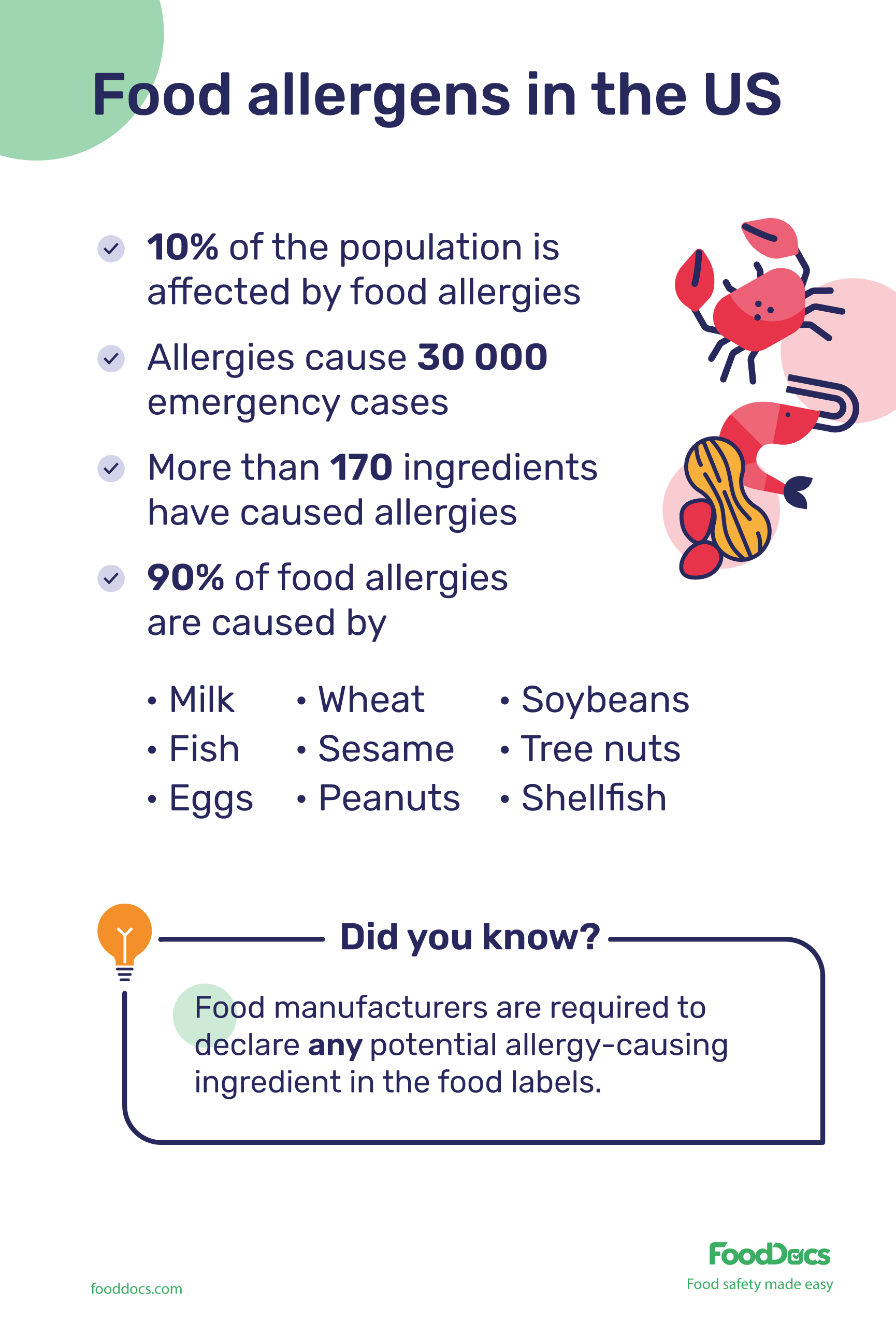
The most common food allergy among adults in the U.S. is associated with shellfish, followed by peanuts and tree nuts. In addition to these food allergens, allergic reactions to milk have been recorded to affect a significant population of children in the U.S.
Particularly in the U.S., a total of nine food allergens are recognized to affect consumers the most. The major food allergens in the U.S. include the following:
Effective in January 2023, sesame will be added as a major food allergen in the U.S. This amendment came after the report of increasing cases of allergy to sesame among Americans. A study published in 2019 revealed that at least 1.5 million customers from the U.S. are allergic to sesame.
According to the Food Allergen Labeling and Consumer Protection Act of 2004 (FALCPA), these food allergens make up 90% of the reported allergic reaction cases connected with food in the U.S. The same law requires that the 9 major food allergens in the U.S. must be listed in the ingredients list if the product contains any trace of them.
.webp?width=1030&height=1536&name=Big%209%20allergens%20in%20the%20US%20(1).webp)
Food Allergy Poster from FoodDocs
Food allergies are estimated to cause the U.S. economy $24.8 billion every year, which is approximately $4,184 per child per year. Expenses and costs accumulated related to food allergies are divided into 4 categories:
A huge portion of the translated loss from food allergy comes from the loss of productivity of affected customers and their family members. Especially for families assisting their children suffering from food allergies, productivity is lessened and affects the economy directly.
With approximately 15 million American consumers affected with food allergies, at least 30,000 emergency health care visits occur every year, from which 150-200 deaths occur. In a report given by the Centers for Disease Control and Prevention, a large portion of food allergy reaction cases over the years originated from dining at a restaurant.
Aside from the milk rash and swelling of the mouth, some food allergy reactions can be adverse, especially for more vulnerable customers. Other symptoms may include:
The most serious cases of food allergy that are most prone to leading to death manifest as anaphylaxis. This medical condition includes several of the listed symptoms above in exaggeration. and requires immediate medical attention.

Most recent reports say that Australia has the highest number of consumers with confirmed food allergies. Approximately 10% of infants in Australia are diagnosed with at least one food allergy, 4-8% in children, and 2% in adults.
Australia is followed by the UK and the US for the number of customers with food allergies all over the world.
The breach of food allergy protection rules can be a significant problem for food businesses. In case of unpreparedness, the worst cases can lead to the death of consumers. Even food allergen traces can trigger severe reactions, especially in immunocompromised individuals.
Food business owners have the responsibility to inform their customers of any potential food allergens in their food and the dangers of consuming them. The Food Allergen Labeling And Consumer Protection Act of 2004 in the U.S. requires food businesses to declare ingredients that may contain part or traces of any of the major food allergens.
As part of food allergen control program, food handlers must undergo proper training on how to avoid cross-contact or the unwanted spread of food allergens in the food facility. The best way to prevent cross-contact is to ensure using separate utensils and tools for preparing allergenic and non-allergenic foods. In case of using bigger equipment, proper cleaning and sanitation in between use must be practiced.
In addition, food handlers must also be acquainted with how to use visual aids such as a Food Allergy Poster and Food Allergen Chart. Food safety documents, such as posters, can help remind food handlers which ingredients can potentially endanger consumers.
A digital solution that can help you create a HACCP food safety plan that is accompanied by an Allergen Management Plan offered by FoodDocs. Learn more about how you can get your own food safety plan that is ready for establishment in just 1 hour here.
Failure to indicate any potential food allergen in your products can be considered as a major violation of the Food Allergen Labeling And Consumer Protection Act of 2004. Consumer complaints regarding any type of breach of this law may warrant a full-blown food safety inspection.
More serious cases of causing food allergy reactions without proper labeling can lead to loss of customer confidence and legal actions.
Learn more about how food allergy labeling violation is categorized below.
A study conducted by P&G in 2017 revealed that 9 in 10 Americans use the cleanliness of a food facility as a deciding factor for repeat purchases. Customers tend to have more confidence in food businesses that shows dedication and a strict approach to food safety. They will not have to worry about cross-contact or contamination from allergens or pathogens if they see that a business takes safety seriously.
One of the best ways to show that your business strictly follows food safety standards and laws is to ace a food safety inspection. Below, we discuss some of the most widely cited food violations in the U.S. and some essential information for food businesses.
Food safety violations can be categorized as Priority, Priority Foundation, and Core violations. Food safety violation categories were originally only categorized as critical and non-critical. With the new revisions to the FDA Food Code, violations can now be defined as the following:
Every year, the Food and Drug Administration releases a list of the most cited food safety violations incurred in the industry. The most recent FDA Inspection Observation Data revealed five frequently committed violations:
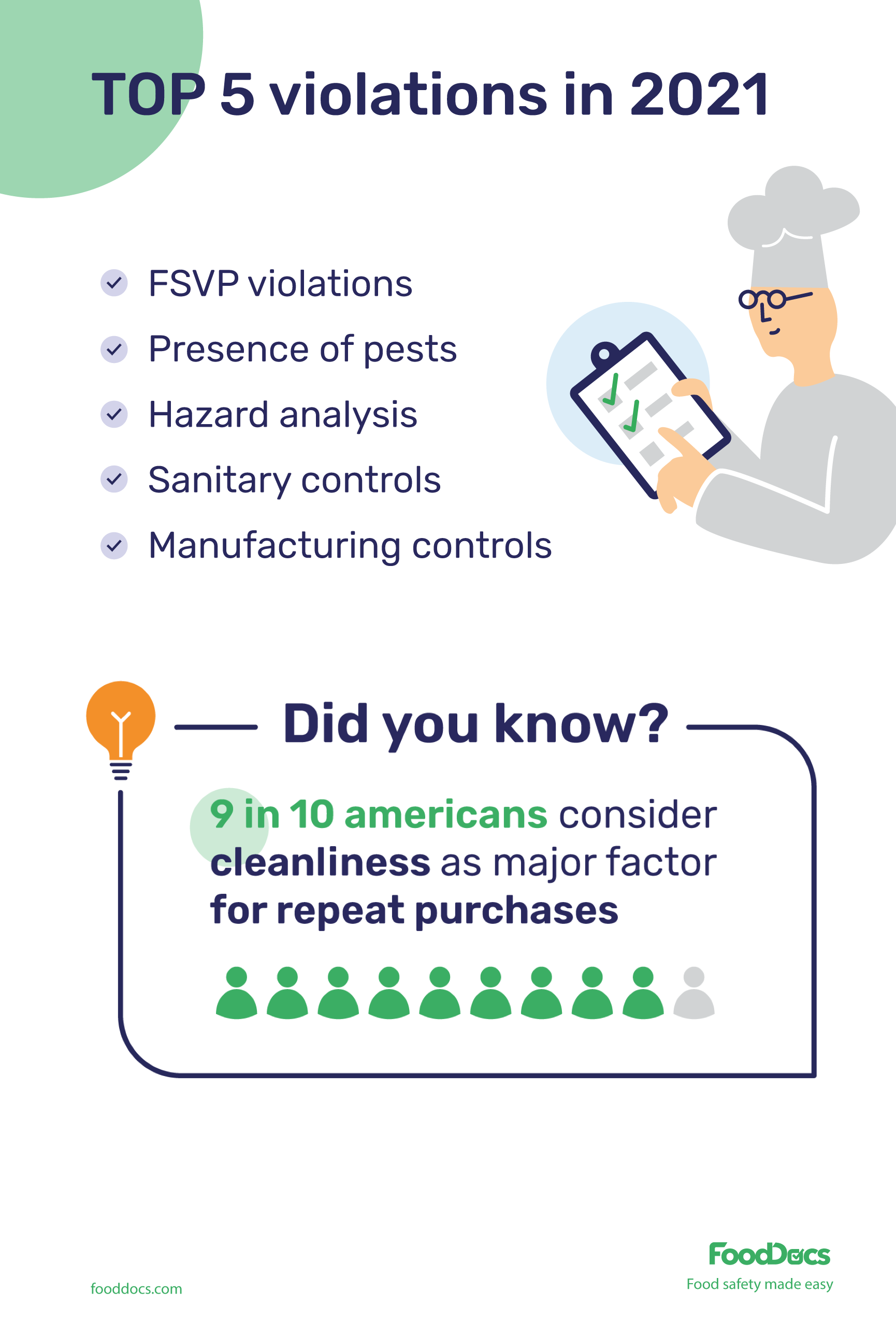
Need help in analyzing food safety hazards and getting your entire HACCP plan established? Use the built-in customizable HACCP plan builder to get a compliant food safety plan in just 1 hour.
Food safety inspections are routinely conducted by federal food agencies and local health governmental departments to consistently ensure compliance with food safety regulations. While food safety inspections are often unannounced, there are different triggers to warrant an inspection from the health department.
Health inspectors can conduct different types of inspections, such as the following:
Other types of inspections may be conducted by independent and private food safety organizations for the verification of food safety compliance and proof of competence. Food inspection reports are given to your team as a summary of the conducted food safety evaluation.

The frequency of food inspections depends on the conducting food safety agency and the category of the food business. On the one hand, FDA conducts its first inspection of a newly opened high-risk food facility within five years of its enactment. Succeeding inspections are conducted thereafter at least once every three years.
On the other hand, foreign facilities are inspected one year after their enactment and double the frequency of inspections when compared to local facilities within the next five years.
Local health departments also conduct independent inspections at least once every two years. High-risk businesses can expect inspections as frequently as every six months, whereas low-risk food establishments once every two years.
Federal food safety inspections are mandated and conducted by either the FDA or the USDA Food Safety and Inspection Service, depending on the nature of a food business.
More commonly, routine inspections are conducted by local health departments. Local departments are more involved when it comes to the implementation of food safety regulations and ensuring compliance from food businesses.
Food safety violations depend on how lax or comprehensive your food safety management system is. As food safety compliance is a consistent and everyday task, your entire team must always be prepared and act accordingly, whether there is an inspection or none.
To help your team consistently maintain food safety compliance use significant tools and additional steps, such as Food Safety Checklists, that contain the most essential tasks that need to be done every day. You can also use Food Safety Posters as a form of training and reminder for food handlers on important rules and regulations in a food facility.
Food safety issues and violations are manifestations of the lack of food safety management in a food business. To ensure consistent compliance with the most important food safety regulations, establish a comprehensive food safety management system.
In case a food safety issue has already occured, it is important to recall food products affected by the issue.
Preventing food safety violations and controlling dangerous illnesses from foods and allergen issues can all be achieved with a food safety management system. This type of food system covers all areas of food safety, including monitoring critical operations, hygiene tasks, labeling, and even managing the competence of your team.
A food safety management system is a program with multiple aspects that are all continuously evolving along with the changes in the food supply chain. It requires a multi-sectoral effort from all the departments of a business. This system is composed of several monitoring programs that are essential for maintaining compliance. Building your own food safety management system manually can take several days and would require the technical expertise of a food safety consultant.
You can get a digital version of a traditional food safety management system, which means a more efficient monitoring system and effective compliance maintenance from FoodDocs. With our software solution, you can easily switch to a digital platform in 15 minutes.
With the help of artificial intelligence and a machine-learning program, our system can guarantee the following benefits to help your team:
Your team can get automatically generated monitoring logs based on the most essential tasks for preventing foodborne illnesses, controlling allergen cross-contact, and controlling inspection violations.
Use tailor-fit monitoring logs such as:
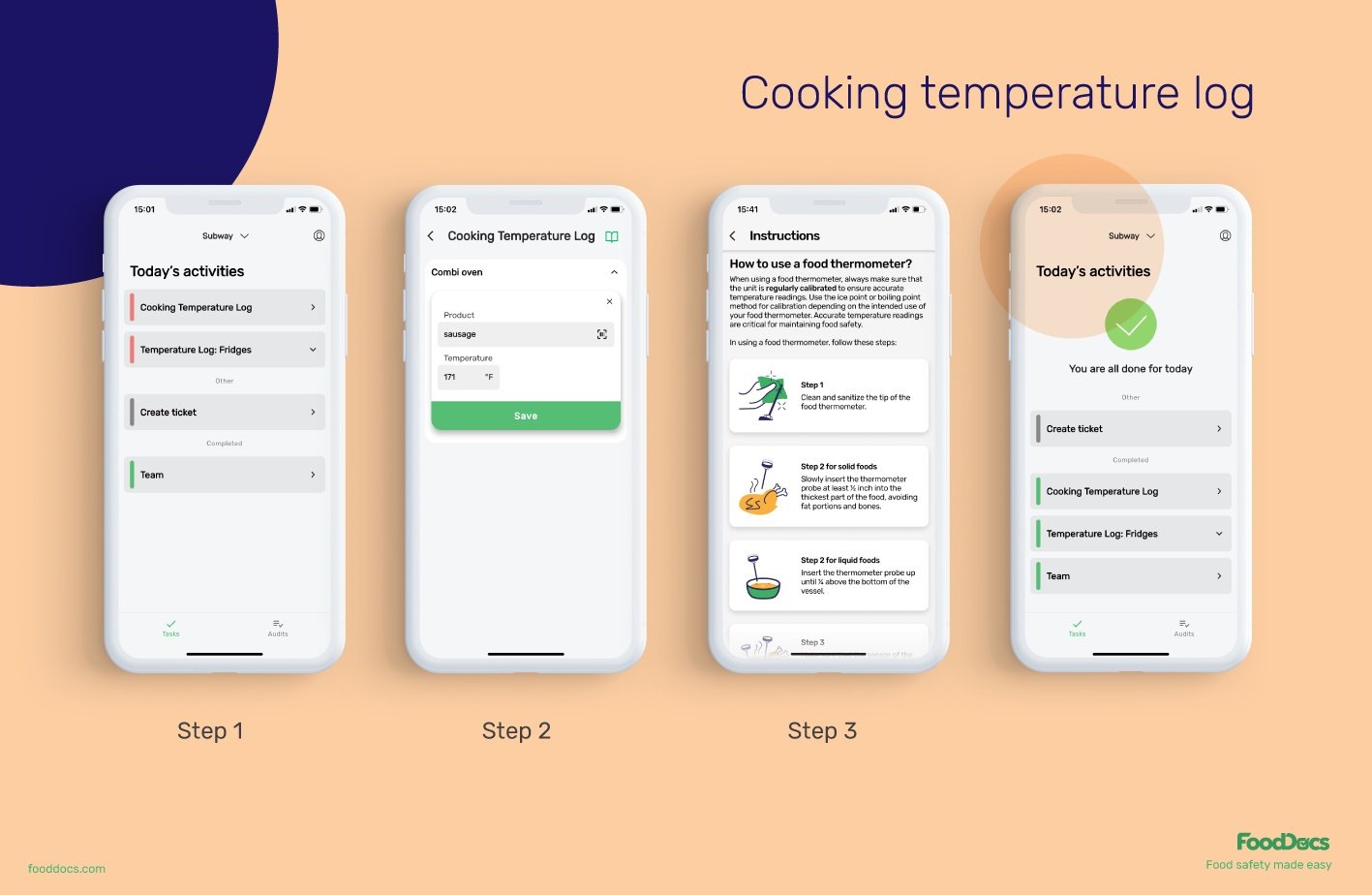
Cooking temperature log from FoodDocs
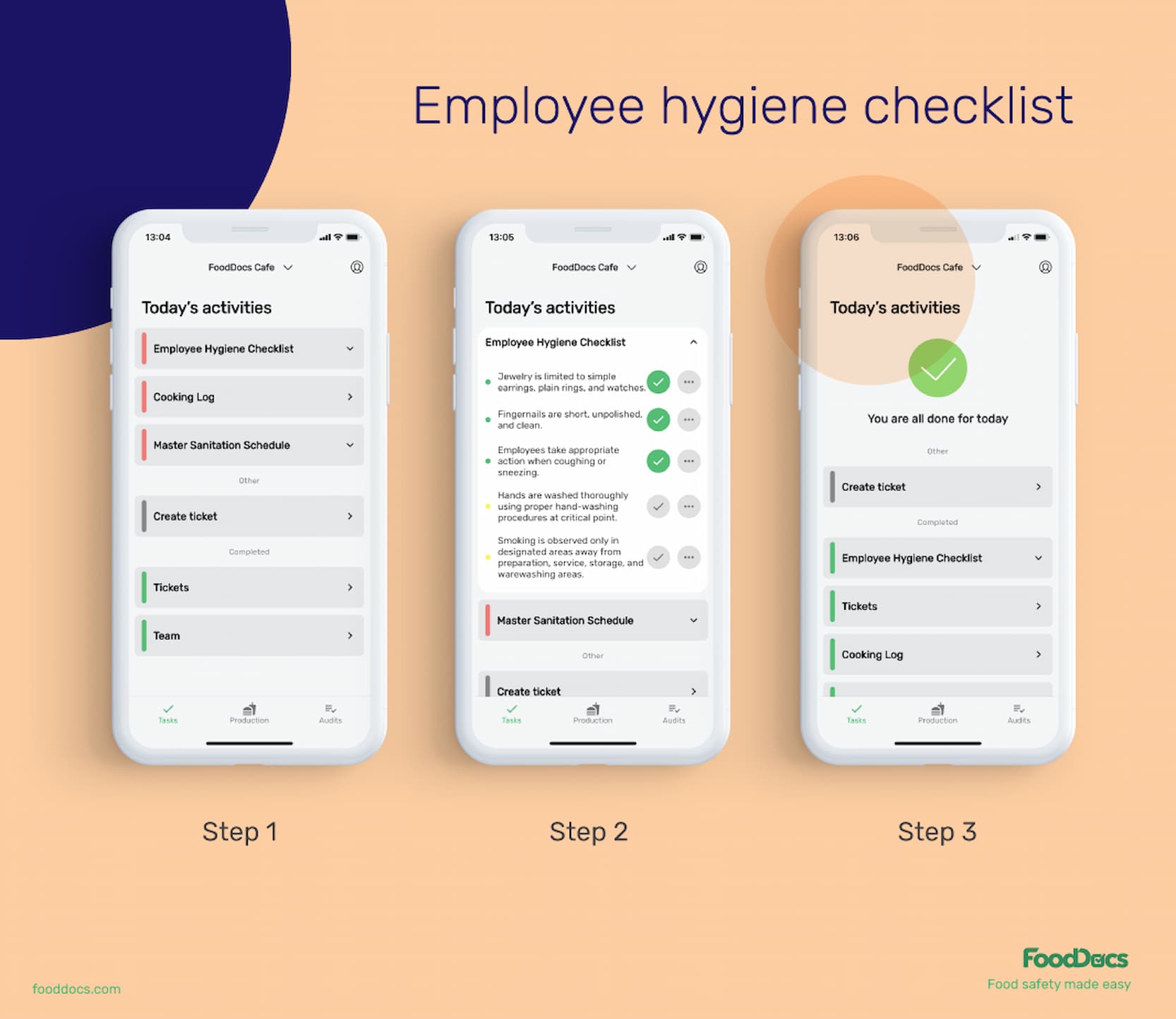
Employee Hygiene Checklist from FoodDocs
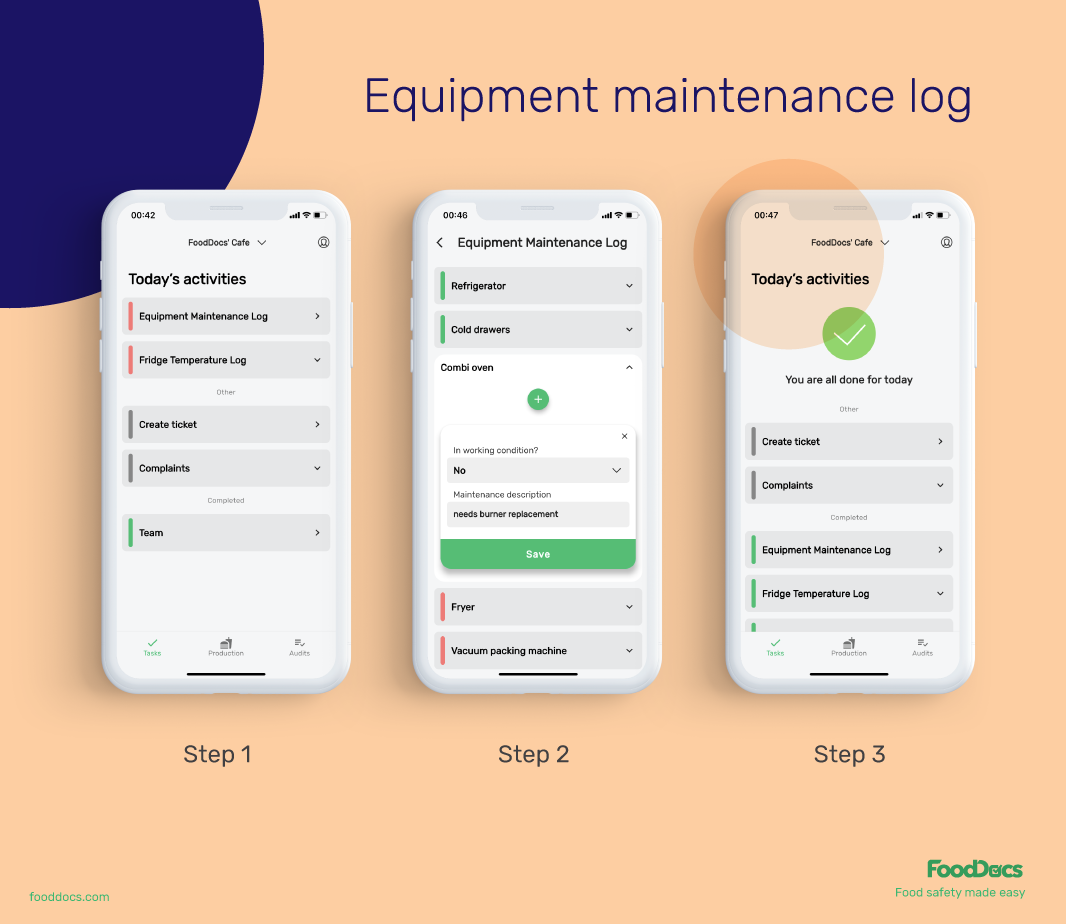
Equipment Maintenance Log from FoodDocs
All generated monitoring logs are equipped with detailed instructions on performing and monitoring the tasks. Use this feature to ensure that food handlers will effectively execute food safety practices every time.
You can also get a smart notification system from our food safety app. This feature sends alerts to food handlers whenever a task needs to be done. With an intuitive notification system, you can ensure that food safety operations are done on time.
In addition, use our digital Food Safety Management System to improve your managing efficiency when it comes to food safety operations. Fulfill this objective using the following features:
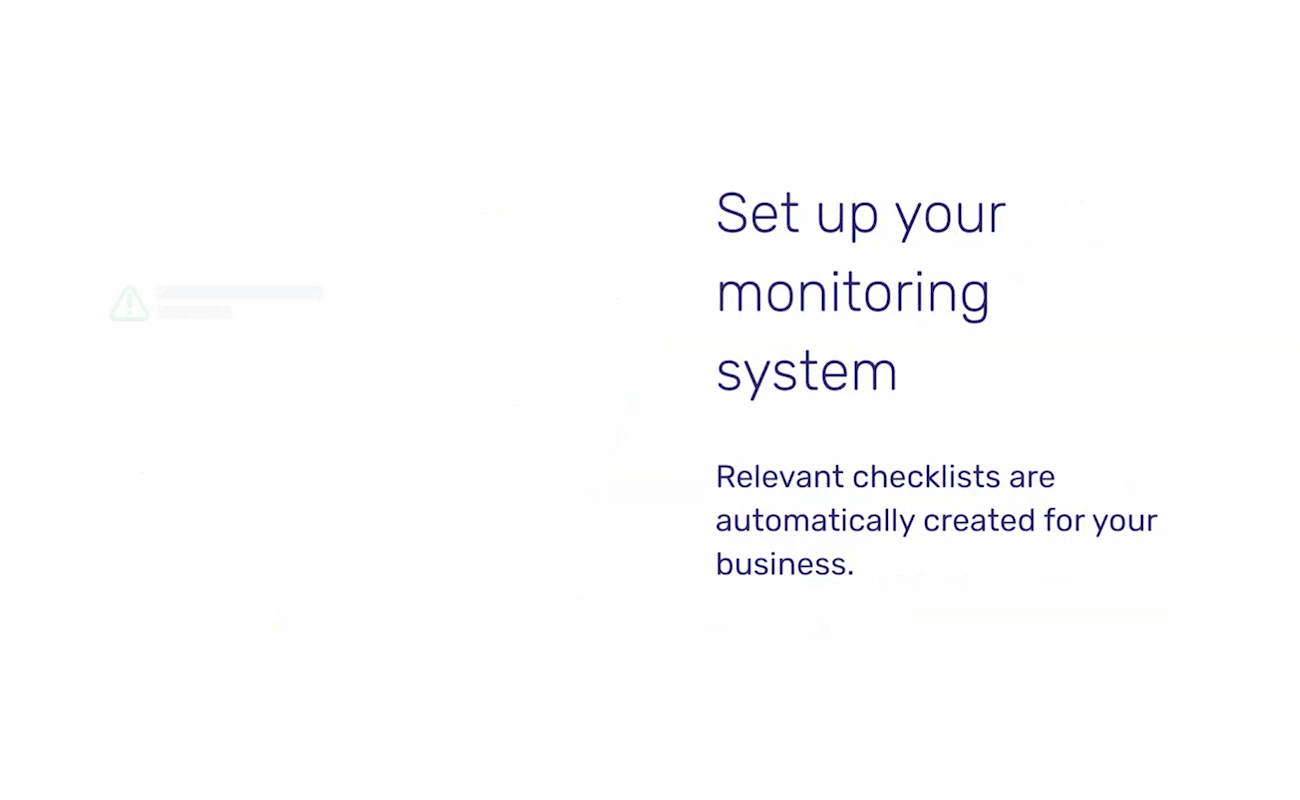
Digital Food Safety Management System from FoodDocs
Save more time while ensuring complete compliance with food safety regulations through our digital Food Safety Management System.
Protect your customers from foodborne illnesses and other food safety issues in the most innovative way yet. At FoodDocs, our objective is to make food safety compliance accessible for all food businesses and to make the food supply chain free from food safety hazards.
Join our list of more than 30,000 customers enjoying food safety compliance using our digital solutions. Use our free 14-day trial now.
Learn challenges healthcare foodservice teams face today and key food safety practices to protect vulnerable patients. Get a free healthcare leader...
Learn what Standard Operating Procedures (SOPs) are and how to write effective SOPs that ensure consistency, efficiency, and safety in your...
Boost your retail food safety with essential practices and digital tools to protect customers and your brand. Plus a free Retail Food Safety Leader...